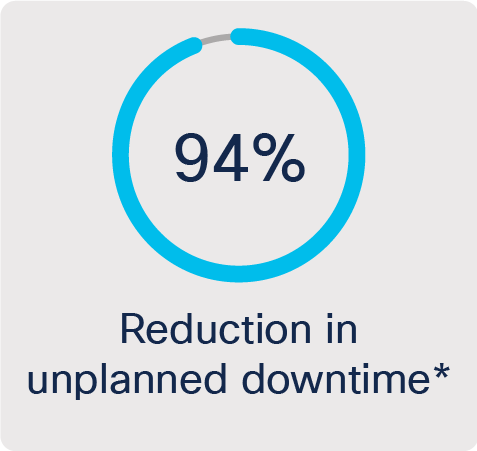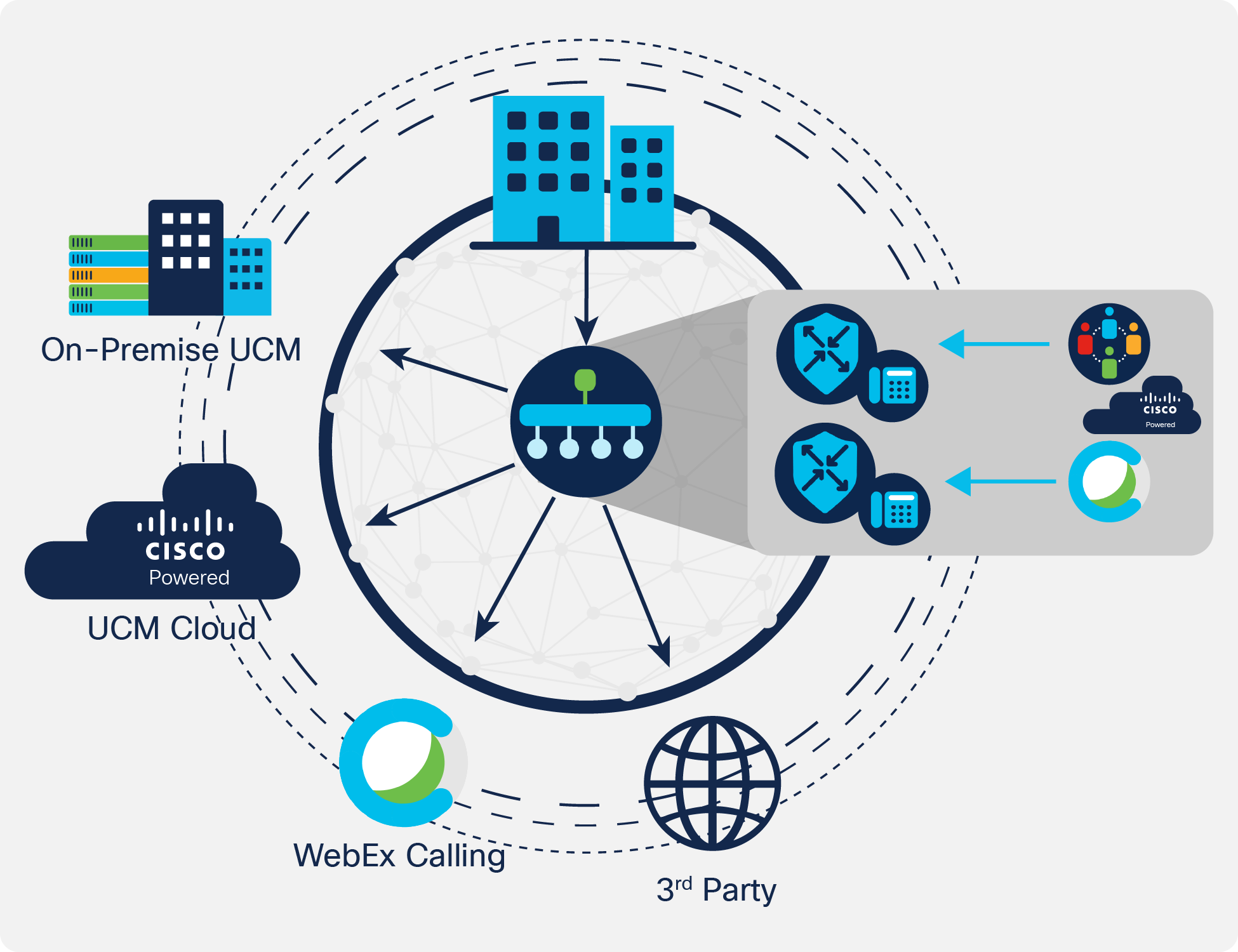Cisco Integrates Unified Communications with Cisco SD-WAN Solution Brief
Available Languages
Bias-Free Language
The documentation set for this product strives to use bias-free language. For the purposes of this documentation set, bias-free is defined as language that does not imply discrimination based on age, disability, gender, racial identity, ethnic identity, sexual orientation, socioeconomic status, and intersectionality. Exceptions may be present in the documentation due to language that is hardcoded in the user interfaces of the product software, language used based on RFP documentation, or language that is used by a referenced third-party product. Learn more about how Cisco is using Inclusive Language.
Cisco is the only vendor to natively integrate analog, digital and IP telephony interfaces directly into the Customer Premise Equipment (CPE).
With both UC and SD-WAN in a single platform, eliminate cost from second device, and reduce support and licensing costs. Integration of UC/Voice on Cisco edge devices ensures that existing equipment investments can be leveraged.
Cisco vManage can orchestrate UC configurations across the entire enterprise via templates and policies. Prioritize specific applications links, with fallback capability in case of link failure or degradation.
Ensuring security and communication integrity
Cisco SD-WAN integrates best-of-breed security with cloud-based Cisco Umbrella or Cisco’s on-premise security portfolio, ensuring security and integrity of your network and Unified Communications.
A compelling need for cloud is driving both modernization and transformation of the WAN. Businesses must balance consistent application delivery, optimize cloud connectivity, and fortify the security of a highly distributed environment. Cisco SD-WAN is a cloud-delivered overlay WAN architecture connecting branches to data center and multicloud environments through a single fabric. Cisco’s edge platforms are an integral part of the Cisco Unified Communications and Collaboration (UC&C) offering.
UC includes both real-time and non-real-time delivery of communications, based on the preferred method and location of the recipient. It integrates enterprise communication services including instant messaging, your “presence” status online, VoIP, audio, video conferencing, and mobility features, such as single-number reach. UC also includes unified messaging, which includes the integration of voicemail, email, SMS, and faxing. UC provides a consistent user experience across your devices. When you receive the same communication on more than one device, you have flexibility as to which method and device you choose to respond with. If you receive a voicemail, you can choose to access it through email on a PC or on your mobile phone. You can also see if the sender is online and decide to reply immediately through an instant message or a video call.
Benefits of Cisco SD-WAN and UC integration
In today’s dynamic and distributed communications infrastructure, simplicity, optimization, security, resiliency, and integration are all critically important to the best possible user experience.
● Telephony integration: Only Cisco natively integrates analog, digital, and IP telephony interfaces directly into edge platforms, reducing complexity.
● Reduced OpEx and CapEx: Cisco SD-WAN now supports UC and SD-WAN within a single platform, resulting in lower support and licensing costs, as well as reducing footprint and leveraging existing Cisco edge platforms you may already be using.
● VoIP Solution Investment Protection: Many customers have large deployments of IP phones and other VoIP solutions. Integration of UC/Voice on Cisco edge devices ensures that existing equipment investments can be leveraged since they are supported in the cloud with Cisco SD-WAN.
● Reduced complexity: Cisco vManage can orchestrate scalable and consistent UC configuration across the entire enterprise via templates to accelerate and standardize deployment.
● Telephony survivability: Prevent internal and external IP phone outages using Cisco Unified Survivable Remote Site Telephony (SRST), enabling a branch router to serve as the fallback IP PBX and gateway to the Public Switched Telephone Network (PSTN). Survivability is further enhanced by LTE backup built into Cisco edge platforms.
● Middle-mile optimization: Only Cisco actively partners with colocation and Software-Defined Cloud Interconnect (SDCI) partners for optimization of cloud applications (Cisco WebEx®, Cisco Unified Communications Manager [UCM] Cloud, and more).
● Ensuring security and communication integrity: Cisco SD-WAN integrates best-of-breed security with cloud-based Cisco Umbrella or Cisco’s on-premise security portfolio, ensuring the security and integrity of your network and Unified Communications.
Cisco SD-WAN integrated UC capabilities
Cisco has the ability to recognize and prioritize applications (such as WebEx) through the application recognition engine and to set policies that enable application traffic to use Multiprotocol Label Switching (MPLS) links and then switch to other WAN links if MPLS failure or Service-Level Agreement (SLA) degradation occurs.
With Cisco, you can perform forward error correction and packet duplication for priority traffic, which will help ensure better performance across a variety of network link types (MPLS, internet) through the recovery of data lost on the link. Cisco SD-WAN Cloud OnRamp functionality provides optimal performance for UC applications hosted in a Software-as-a-Service (SaaS) cloud through optimization of the path to the cloud from branch and remote locations.
● Application visibility is the cornerstone of any SD-WAN solution, not only from a monitoring standpoint, but also in the form of policy construction. If you want to prioritize UC traffic, simply select the Unified Communications Application Family. SD-WAN uses Deep Packet Inspection technology to determine the application type without the need for explicit configuration of packet properties such as Differentiated Services Code Point (DSCP) values or port or IP addresses.
● Application-aware routing computes optimal data traffic paths, helping assure service levels for UC applications and voice. Cloud OnRamp automates the selection of the best-performing path to cloud-based UC services, including the choice of Direct Internet Access (DIA) for remote locations.
● Quality of Service (QoS) prioritizes bandwidth for UC and voice traffic. You can modify the packet forwarding flow with centralized and localized data policies. Automation of QoS deployments using vManage simplifies and helps assure the best quality for voice and video.
● Per-VPN topology: Virtual Private Networks (VPNs) provide segmentation and enhanced security in the SD-WAN overlay, much as Virtual Routing and Forwarding instances (VRFs) do. Each VPN is isolated and has its own forwarding table. You can create a separate VPN topology for UC traffic (full mesh).
● Packet duplication and Forward Error Correction: Forward Error Correction (FEC) and packet duplication enhancements have been added to Cisco SD-WAN. Packet duplication creates a copy of critical application flows across the SD-WAN fabric. FEC drastically improves audio and video quality over a lossy link such as an internet connection.
● Data policy and traffic engineering: Data policies influence the flow of data traffic through the network based on fields in the IP packet headers and VPN membership. Localized data policies allow you to configure how data traffic is handled at a specific site, including Access Control Lists (ACLs), QoS, mirroring, and policing.
● Geo-redundancy: UC traffic routed through geo-redundant network links enables failover and fallback protections.
Improving productivity when working from anywhere
Moving to a larger remote workforce has driven an increased surge in Unified Communications (UC). UC and SD-WAN are both critical technologies to enable a seamless telepresence designed to bridge the gap between remote, and geographically dispersed, users.

Customers are looking for the benefits of UC and SD-WAN to enable greater flexibility and higher voice and video quality when working from home. Cisco offers integration of both of these solutions in one box — managed by the Cisco® vManage console. The result is lower Operating (OpEx) and Capital (CapEx) Expenses and less complexity.

Cisco SD-WAN with Integrated UC
Cisco offers a robust, integrated UC and secure SD-WAN solution on a single platform to both reduce CapEx and decrease support and licensing costs that reduce OpEx. Integration of UC with Cisco vManage simplifies the deployment and management of these remote UC sites, including automated UC survivability for branch locations.
Today’s remote workforces require flexibility to effectively communicate seamlessly from anywhere, using the methods they prefer with the devices they have available to enable the best user experience.
For more information, visit Cisco SD-WAN and Cisco Unified Communications and Collaboration